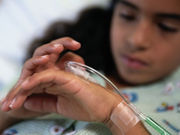No difference in post-discharge treatment failure; more complications, adverse drug events for PICC
THURSDAY, Nov. 17, 2016 (HealthDay News) — For children with complicated pneumonia, peripherally inserted central venous catheter (PICC) and oral antibiotic administration post-discharge have similar rates of treatment failure, according to a study published online Nov. 17 in Pediatrics.
Samir S. Shah, M.D., from Cincinnati Children’s Hospital Medical Center, and colleagues conducted a multicenter retrospective cohort study involving children aged ≥2 months and <18 years discharged with complicated pneumonia between 2009 and 2012. Route of post-discharge antibiotic administration was the main exposure and classified as PICC or oral. The primary outcome assessed was treatment failure.
The researchers found that 13.2 percent of the 2,123 children received antibiotics via PICC. The treatment failure rates were 3.2 and 2.6 among PICC and oral antibiotic recipients, respectively, and did not differ significantly between the groups in across-hospital-matched analysis (matched odds ratio, 1.26; 95 percent confidence interval, 0.54 to 2.94). In 7.1 percent of cases there were PICC complications. In 0.6 percent of children there were adverse drug reactions; the odds of adverse drug reactions were greater in PICC antibiotic recipients in across-hospital-matched analysis (matched odds ratio, 19.1; 95 percent confidence interval, 4.2 to 87.3). PICC antibiotic recipients had higher odds of the composite outcome of all related revisits, which was partially attributed to the high rate of PICC complications and differences in adverse drug reactions (matched odds ratio, 4.71; 95 percent confidence interval, 2.97 to 7.46).
“Children with complicated pneumonia should preferentially receive oral antibiotics at discharge when effective oral options are available,” the authors write.
Full Text (subscription or payment may be required)
Copyright © 2016 HealthDay. All rights reserved.








